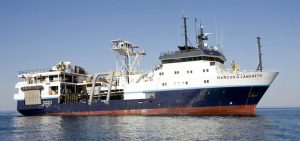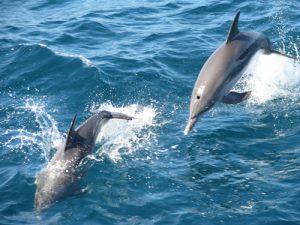 We are proposing two research expeditions (see proposal) to obtain seismic data to investigate the characteristics of the Pacific and North Island, New Zealand, tectonic plates. These expeditions constitute one part of a larger effort to better understand plate tectonics and earthquake seismology in this region. This collaborative effort between the United States, New Zealand, Japan and the United Kingdom would utilize R/V Marcus Langseth, a National Science Foundation flagship research vessel that is used by universities, research institutes and labs across the nation to study Earth’s interior using sound waves. Scheduling of ship assignments for these and other cooperative U.S. academic research vessels is coordinated by the University-National Oceanographic Laboratory System, an organization of 61 academic institutions and national laboratories.
We are proposing two research expeditions (see proposal) to obtain seismic data to investigate the characteristics of the Pacific and North Island, New Zealand, tectonic plates. These expeditions constitute one part of a larger effort to better understand plate tectonics and earthquake seismology in this region. This collaborative effort between the United States, New Zealand, Japan and the United Kingdom would utilize R/V Marcus Langseth, a National Science Foundation flagship research vessel that is used by universities, research institutes and labs across the nation to study Earth’s interior using sound waves. Scheduling of ship assignments for these and other cooperative U.S. academic research vessels is coordinated by the University-National Oceanographic Laboratory System, an organization of 61 academic institutions and national laboratories.
 The R/V Marcus Langseth is operated by Lamont-Doherty Earth Observatory (LDEO) of Columbia University in accordance with U.S. and international rules and regulations. All necessary federal and state permits, authorizations, and approvals are being (or have been) sought for the proposed research activities, including those pursuant to the U.S. Marine Mammal Protection Act (MMPA), Endangered Species Act, and Executive Order 12114 (Environmental Effects Abroad of Major Federal Actions). The MMPA regulatory process includes an opportunity for the public to provide comment on the proposed research activities.
The R/V Marcus Langseth is operated by Lamont-Doherty Earth Observatory (LDEO) of Columbia University in accordance with U.S. and international rules and regulations. All necessary federal and state permits, authorizations, and approvals are being (or have been) sought for the proposed research activities, including those pursuant to the U.S. Marine Mammal Protection Act (MMPA), Endangered Species Act, and Executive Order 12114 (Environmental Effects Abroad of Major Federal Actions). The MMPA regulatory process includes an opportunity for the public to provide comment on the proposed research activities.
 As earth and environmental researchers dedicated to preserving our natural environment, we follow strict procedures to minimize any disruption to protected species. During seismic operations on board the R/V Langseth, we have proposed that five protected-species observers would be on board listening and watching for marine life. If marine mammals or other protected species come within a designated radius of the ship, its sound sources would be shut down. The cruise has been proposed to minimize conflict with marine life, such as marine mammal migrations. Research activities would comply with all U.S. federal and New Zealond regulatory requirements.
As earth and environmental researchers dedicated to preserving our natural environment, we follow strict procedures to minimize any disruption to protected species. During seismic operations on board the R/V Langseth, we have proposed that five protected-species observers would be on board listening and watching for marine life. If marine mammals or other protected species come within a designated radius of the ship, its sound sources would be shut down. The cruise has been proposed to minimize conflict with marine life, such as marine mammal migrations. Research activities would comply with all U.S. federal and New Zealond regulatory requirements.
The Science of Marine Acoustics: Resources
What We Learn From the Oceans Using Sound Waves
Marine Seismic Imaging: Illuminating Earth’s Structure, Climate, Oceans and Hazards
Sound in the Sea
Marine Mammal Protection Guidelines
Marine Mammal Protection Procedures
R/V Marcus G. Langseth
LDEO Office of Marine Operations
Lamont-Doherty Earth Observatory
Discovery of Sound in the Sea
Go back to the main Hikurangi Subduction Zone Seismic Studies page.
